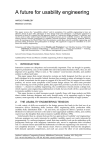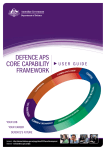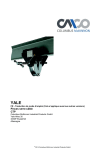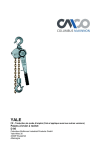Download User Manual Understanding COPD (UCOPD) Questionnaire
Transcript
Understanding COPD (UCOPD) Questionnaire User Manual [Version 1.0 - Date: 12.01.2012] Dr Brenda O’Neill1 Dr Denise Cosgrove1 Dr Joseph MacMahon2 Dr Judy Bradley1,2 1 Health and Rehabilitation Sciences Research Institute, University of Ulster, Shore Road, Newtownabbey, Northern Ireland, BT37 0QB 2 Department of Respiratory Medicine, Belfast City Hospital, Belfast Health and Social Care Trust 51 Lisburn Road, Belfast, Northern Ireland, BT9 7AB Contents 1. A guide to the UCOPD questionnaire Page 3 2. Background of the UCOPD questionnaire 4 3. Administration of the UCOPD questionnaire 5 4. Dealing with queries 6 5. Scoring the UCOPD questionnaire 8 6. Making changes or adding questions to the UCOPD questionnaire 11 7. Accessing further information 11 8. Frequently asked questions 11 9. References 11 Appendix 1: Understanding COPD questionnaire scoring sheet 12 2 1. A guide to the UCOPD questionnaire What is the Understanding COPD questionnaire? Self-efficacy is the belief, or confi dence, an individual has that they can perform a specific behaviour, and is a strong predictor of behaviour change. Knowledge, understanding and selfefficacy are required to induce the behaviour change required for self-management. The conceptual framework for the UCOPD questionnaire relates to understanding, self-efficacy and satisfaction with the educational component of pulmonary rehabilitation. Patient satisfaction is also central to the success of education during pulmonary rehabilitation because active participation in rehabilitation is fundamental to physical improvement and learning new skills. The UCOPD questionnaire is an 18-item, COPD-specific questionnaire that is designed to assess the patient’s perception of their understanding, confidence, and use of key selfmanagement skills. It also has a short section (6 questions) which assesses the patient’s satisfaction with the education component of pulmonary rehabilitation. The UCOPD questionnaire can be completed in less than 10 minutes. The following domains are assessed by the UCOPD questionnaire: Section A About COPD (questions 1-7): This section assesses the patient’s understanding of COPD and self efficacy with recognising and managing exacerbations and taking their medications. • Managing Symptoms (questions 8-14): This section assesses the patient’s use of key selfmanagement skills to manage breathlessness, and their understanding and self efficacy in taking part in exercise and managing psychosocial issues. • Accessing Help and Support (questions 15-18): This section assesses the patient’s self efficacy in accessing aids and appliances, welfare and benefits, facilities for exercise and support groups. • Section B • Satisfaction (questions 1-6): This section assesses the patient’s satisfaction with the education component of pulmonary rehabilitation. Section A (About COPD, Managing Symptoms and Accessing Help and Support) of the UCOPD questionnaire can be completed before and after a pulmonary rehabilitation programme. Section B (Satisfaction) can only be completed after the patient has attended pulmonary rehabilitation. 3 2. Background of the UCOPD questionnaire How was the Understanding COPD questionnaire developed? The UCOPD questionnaire was developed over 5 stages. Stage 1: Important topics for inclusion in the education component of pulmonary rehabilitation and key factors which are important for the delivery of education were identified in a previous focus group study of patients with COPD and health professionals regularly involved in the management of COPD (Wilson J., O’Neill B., et al. 2007). These topics were cross referenced with the current evidence base for pulmonary rehabilitation and education for patients with COPD. The conceptual framework for this questionnaire relates to understanding, self-efficacy and satisfaction, and so questions were developed to assess understanding and self-efficacy relating to these topics, and relating to satisfaction with the educational component of pulmonary rehabilitation (O’Neill B., Cosgrove D., et al. 2012). Health professionals and patients with COPD assessed the face and content validity, usercentredness, feasibility and acceptability of the UCOPD questionnaire. Stage 2: The use of plain English and the readability of the UCOPD questionnaire were assessed using the Drivel Defence software and the Simple Measure of Gobbledygook (SMOG) formula. The Drivel Defence software calculates the number of sentences below and above 20 words and provides potential alternative words. The SMOG formula estimates the years of education required to understand written text. Stage 3: Confirmatory factor analysis was used to assess the structural validity of the UCOPD questionnaire. Stage 4: Test-retest reliability and internal consistency were assessed in patients with COPD. Patients completed the questionnaire on two occasions, one week apart. Stage 5: The responsiveness of the UCOPD questionnaire to pulmonary rehabilitation was established in patients with COPD. Patients completed the questionnaire before and after a pulmonary rehabilitation programme. The convergent validity of the UCOPD questionnaire was assessed by comparing it to an existing knowledge questionnaire. Floor and ceiling effects were explored by establishing the range of patients’ scores and the numbers of patients who obtained the minimum and maximum possible scores for each domain and section. During the development and testing of the UCOPD questionnaire any queries that patients had raised during its administration were recorded. These were reviewed and amendments were made to improve the questionnaire layout, comprehension, ease of administration and assessment properties. 4 3. Administration of the UCOPD questionnaire The UCOPD questionnaire should be completed in a quiet supervised area. Explain to the patient why they are completing the questionnaire. Inform the patient that it is not a test. Explain that it is important for clinicians, researchers and patients themselves to find out how much they understand about their condition, and how confident they are in managing and controlling their symptoms and in seeking support. Instructions for the patient are provided at the start of the questionnaire. Ask the patient to read these instructions thoroughly before starting to answer the questions. If preferred, the clinician can read the instruction at the top of the front page to the patient. Inform the patient that they should complete the questionnaire honestly and emphasise that there are no right or wrong answers. Patients should complete the questionnaire independently without assistance from health professionals or family members. If the patient is unable to complete/read the UCOPD questionnaire themselves, the questions can be read out for them and/or their responses recorded. The UCOPD questionnaire is designed to assess the patient’s perception so their answers should not be influenced in any way. Responses to each question are recorded using a visual numeric scale, a Visual Analogue Scale with numerical intervals. The visual numeric scale is anchored with word descriptors and has intervals scored from 0 to 10. Higher scores on the visual numeric scale represent greater understanding, confidence, use or satisfaction. Lower scores represent less understanding, confidence, use or satisfaction. The patient is instructed to circle the number on the scale which represents their understanding, confidence, use or satisfaction with each topic. The horizontal line of the visual numeric scale should be 10cm in length. When you print the UCOPD questionnaire, please ensure that the line remains 10cm as some printers and photocopiers may alter the scaling of the questionnaire. If scaling does occur please change your printer/photocopier settings appropriately. Once the patient has completed the UCOPD questionnaire, the questionnaire should be checked to make sure that there is a response to all questions and that they have all been completed correctly. If a question has been missed, ask the patient to complete it. If the UCOPD questionnaire is being completed on subsequent occasions, for example after the completion of a pulmonary rehabilitation programme, or at a follow-up appointment, the patient should not be aware of their previous scores until they have completed all responses. If the UCOPD questionnaire is being completed after pulmonary rehabilitation, inform the patient that it is also important to find out how satisfied they were with the education sessions. This will help to identify areas for future improvement. 5 4. Dealing with queries The UCOPD questionnaire is self-administered; it should be completed independently by the patient. If a patient asks for assistance with a question, it is ok to clarify a question for them but not to provide the answer. When clarifying a question, every effort must be made to avoid influencing the patient’s response. For most questions it may be sufficient to read the question out loud to the patient with particular emphasis on key words in the question. If the patient is unsure how to score or to complete a question remind them that higher scores on the scale represent better understanding, confidence, use or satisfaction and lower scores represent less understanding, confidence, use or satisfaction. Do not tell them what response to insert. Refer to the instructions at the start of the questionnaire for this information. During the testing of the psychometric properties of the UCOPD questionnaire, some queries arose. The following points may provide useful responses to these queries and may help clarify what the question is assessing: • Question 2 assesses the progression of COPD over time rather than daily variations or exacerbations. • Questions 3 to 5, if a patient queries what an exacerbation is, read the question out loud, emphasising the words “a significant worsening of your usual symptoms”. • Question 4, if a patient queries what “therapy” means, inform them that therapy includes the medications and actions they take to manage their respiratory symptoms. • Questions 8 to 10 ask how often the patient uses key self-management skills to manage breathlessness and conserve energy. The patient should not circle the number of times they actually use these skills. Repeat the instructions at the start of the questionnaire to them: “If you do not use them often, then you should circle a lower score on the scale. If you use them often then you should circle a higher score on the scale.” • The examples given in brackets of questions 8 to 10 are not exclusive. Patients may query or suggest other examples. Possible other examples include: o Question 8: blow as you go o Question 9: taking rest breaks between activities o Question 10: sitting down and leaning on furniture (these are positions of ease but patients may not be familiar with the terminology) • Questions 11 and 12, if the patient does not take part in exercise, repeat the question emphasising the words in italics: o Question 11: How well do you understand the benefits of exercise? o Question 12: How confident are you that you can take part in exercise? • Questions 13 and 14 assess the patient’s confidence in managing the psychosocial issues sometimes associated with COPD. If the patient does not currently experience these 6 psychosocial issues, these questions may be interpreted: “If you did experience [psychosocial issue], how confident are you that you can manage it?” • Questions 15 to 18 assess the patient’s confidence in accessing help and support. If the patient does not currently access this help and support, repeat the question emphasising the words in italics: o Question 15: How confident are you that you know how to get aids and appliances if you need them (e.g. shoe horn, shower seat)? o Question 16: How confident are you that you know how to get information about welfare and benefits that you might be entitled to? o Question 17: How confident are you that you know how to access facilities for exercise (e.g. gym, pool, walking clubs)? o Question 18: How confident are you that you know how to get information about local support groups for people with respiratory conditions? 7 5. Scoring the UCOPD questionnaire Scoring the UCOPD questionnaire is very easy. It can be scored either manually using the scoring sheet in Appendix 1 or by using the excel spreadsheet available on the UCOPD questionnaire website (http://www.science.ulster.ac.uk/ucopd/). Three domain scores are calculated for Section A of the UCOPD questionnaire. A total score for Section A (questions 1-18) can also be calculated. One domain score is calculated for Section B. The scores for the domains and the total score of Section A are presented as percentages where 100% represents better understanding, self efficacy use and satisfaction and 0 represents worse understanding, confidence, use and satisfaction. The questions of the UCOPD questionnaire are equally weighted and therefore, the scores of the domains and Section A are the mean percentage score of the individual questions. To calculate the scores for each domain the scores of the individual questions of the domain are added and then divided by the maximum score of the domain and multiplied by 100. To calculate the total score for Section A the scores of all of the questions in Section A are added, divided by the maximum score and multiplied by 100 The maximum scores of the domains and the total score of Section A are: Section A: • About COPD (questions 1-7) = 70 • Managing Symptoms (questions 8-14) = 70 • Accessing Help and Support (questions 15-18) = 40 • Total score of Section A (questions 1-18) = 180 Section B: • Satisfaction (questions 1-5) = 50 Example: About COPD domain = Sum of questions 1-7 70 x 100 = _% Using the excel data spreadsheet The patient’s responses to the UCOPD questionnaire can be inserted into the excel data spreadsheet. The scores to the individual questions are inserted into column B. When data are missing the cell should be left blank. The totals of the domains of Section A and the total score for Section A are automatically calculated and will be presented in column B, rows 14, 26, 35, 38, 49. You will not be able to alter these cells. 8 Dealing with missing data Missing data can affect the validity and reliability of the UCOPD questionnaire, therefore every effort must be taken during administration to ensure that patients answer all questions. Unfortunately, sometimes despite our best efforts the collection of missing data does occur. When scoring the UCOPD questionnaire it is better to calculate a potential score for the missing question than to leave it blank. You can use the calculations described below. Once the missing item has been calculated it can then be inserted into the scoring sheet or the excel spreadsheet and the total score for the domain calculated as normal. Items missing at the post-pulmonary rehabilitation (follow-up) visit For items missing at the post-pulmonary rehabilitation (follow-up) visit the following calculation can be used to calculate the score of the missing item: Sum of the follow-up scores of items scored at both visits Sum of the baseline scores of items scored at both visits x Baseline score of missing item Example: About COPD domain Pre- pulmonary rehabilitation (baseline) Post- pulmonary rehabilitation (follow-up) Question 1 4 7 Question 2 3 5 Question 3 6 7 Question 4 2 - Question 5 4 8 Question 6 5 9 Question 7 4 6 To calculate the missing score of question 4 at the post-pulmonary rehabilitation (follow-up) visit: 7+5+7+8+9+6 4+3+6+4+5+4 x 2 = 3.2 To calculate the total score of the About COPD domain at the post-pulmonary rehabilitation (follow-up) visit: About COPD domain = 7 + 5 + 7 + 3.2 + 8 + 9 + 6 70 x 100 = 64.6% 9 Items missing at the pre-pulmonary rehabilitation (baseline) visit For items missing at the pre-pulmonary rehabilitation (baseline) visit the following calculation can be used to calculate the score of the missing item: Sum of the baseline scores of items scored at both visits Sum of the follow-up scores of items scored at both visits x Follow-up score of missing item Example: About COPD domain Pre- pulmonary rehabilitation (baseline) Post- pulmonary rehabilitation (follow-up) Question 1 4 7 Question 2 3 5 Question 3 - 7 Question 4 2 3 Question 5 4 8 Question 6 5 9 Question 7 4 6 To calculate the missing score of question 3 at the pre-pulmonary rehabilitation (baseline) visit: 4+3+2+4+5+4 7+5+3+8+9+6 x 7 = 4.1 To calculate the total score of the About COPD domain at the pre-pulmonary rehabilitation (baseline) visit: About COPD domain = 4 + 3 + 4.1 + 2 + 4 + 5 + 4 70 x 100 = 37.3 % 10 6. Making changes or adding questions to the UCOPD questionnaire The UCOPD questionnaire was developed based on key topics which patients with COPD identified as the important topics for inclusion in pulmonary rehabilitation (Wilson J., O’Neill B., et al. 2007). However, in order to meet the other needs of patients with COPD, some pulmonary rehabilitation programmes may cover additional education topics that are not assessed by the UCOPD questionnaire. If a topic that you cover in your pulmonary rehabilitation programme is not assessed by the UCOPD questionnaire, please contact Dr Brenda O’Neill at [email protected]. Additional questions may be available or compiled that could be added to the UCOPD questionnaire to assess these additional topics. 7. Accessing further information For further information about the UCOPD questionnaire, please contact: Brenda O’Neill Room 1F119 PhD, MCSP Health and Rehabilitation Sciences Research Institute University of Ulster Shore Road Newtownabbey Co Antrim BT37 0QB Email: [email protected] Telephone: 028 90 368812 8. Frequently asked questions For frequently asked questions please see the UCOPD questionnaire website (http://www.science.ulster.ac.uk/ucopd/). 9. References 1. Wilson JS, O’Neill B, Reilly J, MacMahon J, Bradley JM. Education in Pulmonary Rehabilitation: The Patient’s Perspective. Archives of Physical Medicine and Rehabilitation 2007; 88(12):1704-1709. 2. O’Neill B, Cosgrove D, MacMahon J, McCrum-Gardner E, Bradley JM. Assessing education in pulmonary rehabilitation: the Understanding COPD Questionnaire (UCOPD). Journal of Chronic Obstructive Pulmonary Disease. 2012; 9(2):166-174 (doi:10.3109/15412555.2011.644601) 11 Appendix 1 Understanding COPD questionnaire scoring sheet Patient ID: _______________________________ Date: ______________________ About COPD: Q1 [ ] +Q2 [ ] +Q3 [ ] +Q4 [ ] +Q5 [ ] +Q6 [ ] +Q7 [ ]=[ ] x100 = [ ]% 70 Managing Symptoms of COPD: Q8 [ ] +Q9 [ ] +Q10 [ ] +Q11 [ ] +Q12 [ ] +Q13 [ ] +Q14 [ ]=[ ] x100 = [ ]% 70 Accessing Help and Support: Q15 [ ] +Q16 [ ] +Q17 [ ] +Q18 [ ]=[ ] x100 = [ ]% 40 Section A total score: About COPD [ ] + Managing Symptoms [ ] + Accessing Help [ ]=[ ] x 100 = [ ]% 180 Section B total score: Q1 [ ] +Q2 [ ] +Q3 [ ] +Q4 [ ] +Q5 [ ]=[ ] x100 = [ ]% 50 12 Example of scoring the UCOPD questionnaire Patient ID: _______________________________ Date: ______________________ About COPD: Q1 [ 7 ] + Q2 [ 8 ] + Q3 [ 6 ] + Q4 [ 7 ] + Q5 [ 8 ] + Q6 [ 9 ] + Q7 [ 8 ] = [ 53 ] x100 = [ 76 ]% 70 Managing Symptoms of COPD: Q8 [ 9 ] +Q9 [ 7 ] +Q10 [ 9 ] +Q11 [ 9 ] +Q12 [ 67 ] +Q13 [ 2 ] +Q14 [ 7 ] = [ 50 ] x 100 = [ 71 ]% 70 Accessing Help and Support: Q15 [ 7 ] +Q16 [ 5 ] +Q17 [ 9 ] +Q18 [ 5 ] = [ 26 ] x 100 = [ 65 ]% 40 Section A total score: About COPD [ 53 ] + Managing Symptoms [ 50 ] + Accessing Help [ 26 ] = [ 129 ] x 100 = [ 72 ]% 180 Section B total score: Q1 [ 7 ] +Q2 [ 9 ] +Q3 [ 8 ] +Q4 [ 7 ] +Q5 [ 7 ] = [38 ] x100 = [ 76 ]% 50 13 Alternative scoring sheet for the UCOPD questionnaire Patient name: Pre- pulmonary rehabilitation Date: Post- pulmonary rehabilitation Date: About COPD domain Question 1 Question 2 Question 3 Question 4 Question 5 Question 6 Question 7 About COPD (Sum of questions 1-7 / 70 x 100) Managing Symptoms of COPD domain Question 8 Question 9 Question 10 Question 11 Question 12 Question 13 Question 14 Managing Symptoms of COPD (Sum of questions 8-14 / 70 x 100) Accessing Help and Support domain Question 15 Question 16 Question 17 Question 18 Accessing Help and Support (Sum of questions 15-18 / 40 x 100) Section A (Sum of questions 1-18 / 180 x 100) 14 Satisfaction domain Post- pulmonary rehabilitation Date: Question 1 Question 2 Question 3 Question 4 Question 5 Satisfaction (Sum of questions 1-5 / 50 x 100) 15 Example of scoring the UCOPD questionnaire Patient name: Pre- pulmonary rehabilitation Date: EXAMPLE Post- pulmonary rehabilitation Date: EXAMPLE About COPD domain Question 1 4 7 Question 2 7 8 Question 3 2 6 Question 4 4 7 Question 5 9 8 Question 6 9 9 Question 7 3 8 54% 76% Question 8 8 9 Question 9 4 7 Question 10 7 9 Question 11 6 9 Question 12 6 7 Question 13 2 2 Question 14 3 7 51% 71% Question 15 5 7 Question 16 0 5 Question 17 8 9 Question 18 2 5 38% 65% 49% 72% About COPD (Sum of questions 1-7 / 70 x 100) Managing Symptoms domain Managing Symptoms of COPD (Sum of questions 8-14 / 70 x 100) Accessing Help and Support domain Accessing Help and Support (Sum of questions 15-18 / 40 x 100) Section A (Sum of questions 1-18 / 180 x 100) 16 Satisfaction domain Question 1 Question 2 Question 3 Question 4 Question 5 Satisfaction (Sum of questions 1-5 / 50 x 100) Post- pulmonary rehabilitation Date: EXAMPLE 7 9 8 7 7 76% 17






















